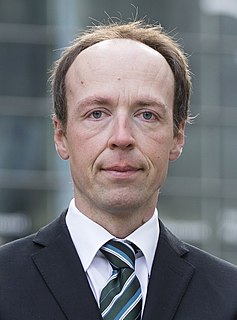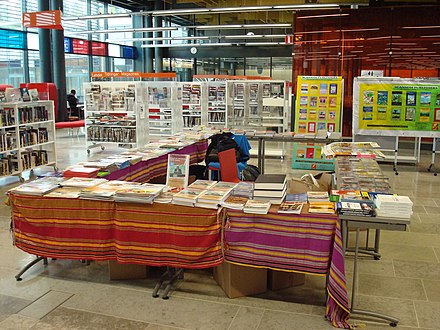
Turku is a city on the southwest coast of Finland at the mouth of the Aura River, in the region of Southwest Finland (Varsinais-Suomi). Turku, as a town, was settled during the 13th century and founded most likely at the end of the 13th century, making it the oldest city in Finland. It quickly became the most important city in Finland, a status it retained for hundreds of years. After Finland became part of the Russian Empire (1809) and the capital of the Grand Duchy of Finland was moved to Helsinki (1812), Turku continued to be the most populous city in Finland until the end of the 1840s, and it remains a regional capital and an important business and cultural center.
Helsingin Sanomat, abbreviated HS and colloquially known as Hesari, is the largest subscription newspaper in Finland and the Nordic countries, owned by Sanoma. Except after certain holidays, it is published daily. Its name derives from that of the Finnish capital, Helsinki, where it is published.

Närpes is a town and municipality of Finland.

Zahra Abdulla is a Somali-born Finnish politician. She was a member of the Helsinki City Council from 1997 to 2017, representing the Green League.
Russians in Finland or Russian Finns constitute a linguistic and ethnic minority in Finland. About 30,000 people have citizenship of the Russian Federation, and Russian is the mother language of about 70,000 people in Finland, which represents about 1.3% of the population.

Jussi Kristian Halla-aho is a Finnish politician and a member of the Parliament of Finland (MP). He is the leader of the Finns Party, part of the Identity and Democracy.

Immigration to Finland is the process by which people migrate to Finland to reside in the country. Some, but not all, become Finnish citizens. Immigration has been a major source of population growth and cultural change throughout much of the history of Finland. The economic, social, and political aspects of immigration have caused controversy regarding ethnicity, economic benefits, jobs for non-immigrants, settlement patterns, impact on upward social mobility, crime, and voting behavior.
Robert Rantala is a 7-year-old child with Russian-Finnish dual citizenship who was taken by the Finnish social service to a children’s shelter in early 2010. Russian media followed closely the incident for weeks. The boy escaped from school to his parents and Russia's Commissioner for Children Pavel Astakhov visited in Finland.
There is a small community of Indians in Finland consisting mainly of Finnish citizens of Indian origin or descent as well as expatriates from India.

Presidential elections were held in Finland in January and February 2012. The first round took place on 22 January 2012 with advance voting between 11 and 17 January. Since no candidate received a majority of the vote, a second round was held on 5 February, with advance voting between 25 and 31 January. Sauli Niinistö was elected the President of Finland for a term from 1 March 2012 until 2018.

The Stadin Derby, or The Helsinki Derby, is the name for a Helsinki association football fixture played between HIFK Fotboll and HJK Helsinki. The name of the derby derives from the common slang word nickname for Helsinki (Stadi), widely used by the locals. Both the teams play at the highest level of football in Finland, in Veikkausliiga. Before 2015, the clubs hadn't faced each other at the highest level since 1972 when HIFK got relegated from the top league, which was then known as Mestaruussarja.

Helsinki City Bikes is a public bicycle system in Helsinki and Espoo and integrating with the rest of the public transport in Helsinki since May 2016. It is operated as a public-private partnership between Helsinki Regional Transport Authority (HSL), Helsinki City Transport (HKL), Espoo Technical and Environment Services, Moventia and Smoove.
Romanians in Finland are immigrants from Romania residing in Finland.
Arabs in Finland are residents and citizens of Finland who speak the Arabic language.

Movement Now is an economically liberal political movement in Finland. Movement Now was founded by National Coalition Party (KOK) member of parliament (MP) Harry "Hjallis" Harkimo and seven other people.
Nigerians in Finland are residents and citizens of Finland of Nigerian ancestry. They are Finland's second largest African immigrant group after Somalis.
Syrians in Finland are immigrants from Syria residing in Finland. They are the second largest Arab community in Finland after Iraqis.
Chileans in Finland are people from Chile residing in Finland.





















